

![]()
![]()
This Page:
Mariquita S. Gill
Rosalie Lorraine Gill
Kathleen H. Greatorex
Lillian S. Greene
Helen Gregory
Alice V. Guysi
Jeanette Guysi
Johanna Woodwell Hailman
Ellen Day Hale
Mary Hallock-Foote
Maria Hallowell
Annie L. Harmon
Letitia B. Hart
Ida C. Haskell
Adele M. von Helmold
Lucy D. Holme
Edith M. W. Howes
Grace Carpenter Hudson
![]()
![]()

Willows by the River, Giverny--
representative work.
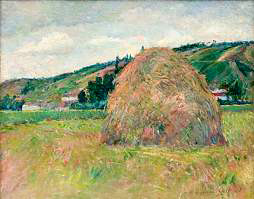
Sunlight on a Haystack, Giverny--
representative work.
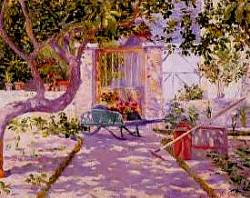
A Bit of our Garden, Giverny--representative work
A Grey Day, Giverny, France, A Mid-summer Morning,
Giverny (images unavailable)--exhibited
in the Fine Arts Palace, 1893 Exposition
Mariquita S. Gill was born in Montevideo, Uruguay and studied art in New York at the Art Students League and in Paris at the Académie Julian. Discovering the impressionists (particularly Pissarro. along with Monet), she moved to Giverny during the 1890s and enthusiastically painted and studied their methods. Returning to America, she spent the remainder of her career in Massachusetts and exhibited often.
Biography/Images --click on "Examples of Work"
![]()
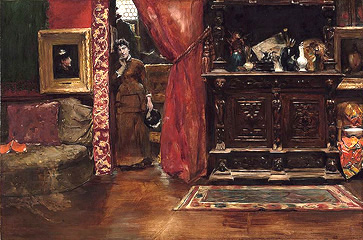
New Model 1884--
representative work.
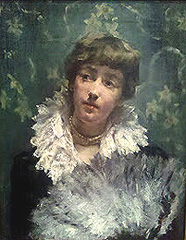
Lady with a Fan 1884--
representative work.
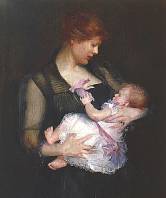
The Orchid 1889--
exhibited at 1893 Exposition.
Twilight on St. Ives Bay and Portrait of Miss Inglis
(images unavailable)--exhibited in the
Fine Arts Palace, 1893 Exposition
Chat (images unavailable)--exhibited in the Rotunda,
Women's Building, 1893 Exposition
Born in New York, Rosalie Lorraine Gill was raised by a father, a third-generation tea-importer, who encouraged her interest in art. She began studying at the Art Students League in New York at age twelve, later under William Merritt Chase, and was winning awards by age 17. By 1888 she was in Paris studying under Alfred Stevens and exhibiting . She and her husband Rene Lara remained in Paris the rest of their lives. Her married name and title are Mme. Rene Lara, Comptesse de Chalan.
![]()

Wicker Weavers, Ellenville, NY
(glassworks)--representative work
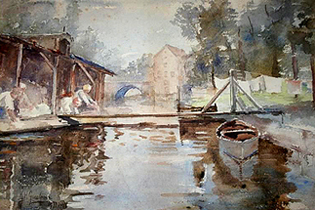
Le Jardin Fleuri--
representative work.
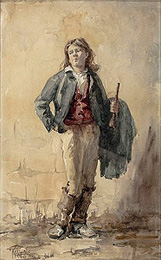
French Boy Holding a Horn
1880--representative work.

Group of Models--
representative work.
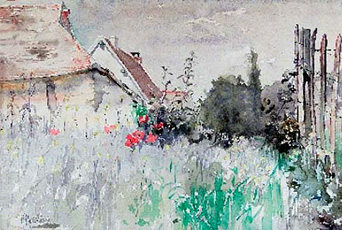
Flower Garden 1889--
representative work.
Carnival and Corner of the Strozzi Palace, Florence
(images unavailable)--exhibited
in the Fine Arts Palace, 1893 Exposition
Bateau Lavoir-Moret (image unavailable)--exhibited
in the Rotunda, Women's Building, 1893 Exposition
Kathleen H. Greatorex was born in New Jersey to Henry Wellington Greatorex, a church music composer and concert performer, who died when she was seven. Kathleen and her sister Elizabeth studied art under their widowed artist-mother (Eliza Pratt Greatorex) who supported the family by teaching art and by sales of her artworks. The daughters continued their studies in New York, Rome, and Munich. During the 1880s and 90s, Kathleen exhibited in Paris and Chicago and taught art in New York. The three Greatorex women artists became part of the art colony in Cragsmoor, New York and traveled extensively in Europe, Africa, and the U.S.
![]()

My Garden, Kennebunk--
representative work.
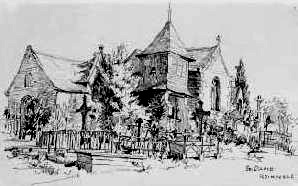
St. David, Quimperle--
representative work.

Modesty
1885--representative work
A Brittany Landscape (image unavailable)--exhibited
in the Fine Arts Palace, 1893 Exposition
Lillian Greene was born in New York and trained in Boston at the Museum of Fine Art and in Paris at the Académie Julian under Jules-Joseph Lefebvre and Tony Robert-Fleury. She married William Greene. No other information is available online.
![]()
Joy--go to Women's Building page;
frieze art exhibited in the Reception Room,
Illinois State Building, 1893 Exposition
Helen Gregory was born in Ann Arbor, Michigan to John and Julia Gregory. She was a student at the Art Students League of New York and at the Academy Colarossi in Paris and evidently lived for a time in the District of Columbia. No other information is available online.
![]()
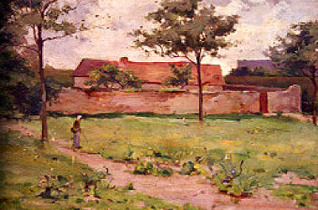
[title unknown]--representative work
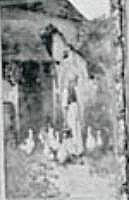
Girl and Geese [very poor scan]--
exhibited in the Cincinnati Room,
Women's Building, 1893 Exposition
Alice V. Guysi was born in Cincinnati to Harriet and George W. Guysi, a city official. Educated at home and exhibiting locally by age sixteen, she and her younger sister Jeanette Guysi both went on to study art with William Sartain at the National Academy of Design in New York and in Paris at the Colarossi Academy with Harry Thompson during the 1880s and early 1890s. The sisters exhibited in the Women's Building at the 1893 Exposition and moved to Detroit where Alice taught at the Detroit Museum of Art for the rest of her life and was well-known for her miniature portraits and other works.
![]()

[Title unknown] --
representative work.
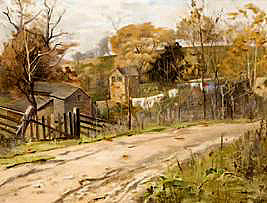
Courtyard Airaines in Picardie France 1893--
exhibited in Women's Building, 1893 Exposition.
(Note: Title listed incorrectly as "in Pieardie" on online sources.)
Jeanette Guysi was born in Cincinnati to Harriet and George W. Guysi, a city official. Educated at home, she and her older sister Alice V. Guysi both went on to study art with William Sartain at the National Academy of Design and in Paris at the Colarossi Academy during the 1880s and early 1890s. The sisters exhibited in the Women's Building at the 1893 Exposition and moved to Detroit where Jeannette, known for her landscape and still-life works, was a life-long art educator in the Detroit public schools. It is not known if the painting above ("Title Unknown") is by Jeannette or by her sister Alice.
![]()
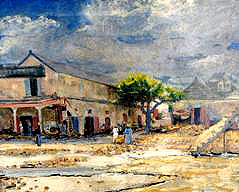
Southwest--
representative work.
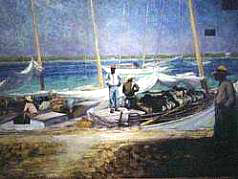
Nassau (Bahama Island Port
Scene)--representative work.

Pittsburgh River Scene1929--
representative work.

Mills,
Trains and Barges
1940--representative work.

Portrait of Alice Herron Woodhall 1924--
representative work
Study Head of a Young Girl and Portrait of Miss L
(images unavailable)--exhibited in the
Fine Arts Palace, 1893 Exposition
Johanna Woodwell Hailman was born into a wealthy Pennsylvania family and trained primarily by her artist-father (Joseph Woodwell) and at the Pittsburgh School of Design for Women. She traveled widely, painting landscapes in Europe and the Bahamas, but is especially known for her paintings of the flowers in her garden and for industrial Pittsburgh scenes. Hailman was an early supporter of the city beautification movement. She married steel industrialist James H. Hailman.
![]()
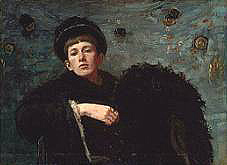
Self-Portrait (1885)--
[Museum of Fine Art, Boston]
representative work.

Musical Interlude--
representative work.
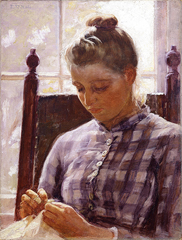
June--
representative work.
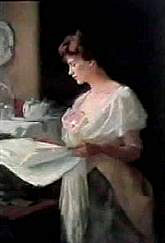
Morning News--
representative work.
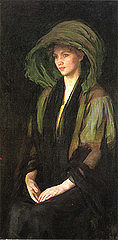
Self-Portrait (1885)--
representative work.

Willow Whistle--representative work.
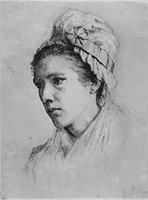
Woman of Normandy
(Woman in a Cap) (1880)
--representative work.
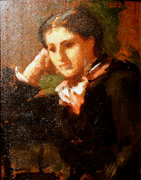
Charlotte Perkins
Stetson Gilman--
representative work.
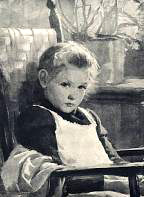
Bessy (1890)--
exhibited in the
Fine Arts Palace,
1893 Exposition.

Portrait of a Woman
(supposedly Gabrielle
Clements) 1883--
representative work.
2 dry points, both titled Study of a Head, and Under the Vine
(images unavailable)--exhibited in the
Fine Arts Palace, 1893 Exposition
Ellen Day Hale was born into a well-known Massachusetts family (her father was the celebrated clergyman-orator-writer Edward Everett Hale who became Chaplain of the U.S. Senate; her great-great-uncle was the Revolutionary War patriot Nathan Hale; her great-aunt was Harriet Beecher Stowe; and her cousin was the feminist author Charlotte Perkins Gilman). She first studied drawing with her aunt Susan Hale and later in Boston, Philadelphia, and Paris at Académie Julian. A member of what is now referred to as the Boston School of Painting, Hale has been recognized as one of America's leading women impressionists. She also wrote History of Art (1888). Her artist brother Philip Hale also exhibited at the Chicago World's Fair. Her lifelong friend and companion was Philadelphia artist Gabrielle de Vaux Clements.
![]()

Portrait of Ellen Emmet Rand
--representative work.

Letter of Resignation--exhibited in the
Women's Building, 1893 Exposition (?)
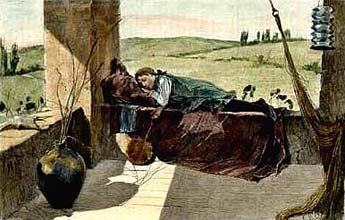
Afternoon at a Ranch (1889)--illustration
for Century Magazine,
--exhibited in
East Gallery, Women's Building, 1893 Exposition.

The Hill Pastures (1889)--illustration for
Century Magazine,--
exhibited in
East Gallery, Women's Building, 1893 Exposition.

The Wood Dove--exhibited in the
Women's Building, 1893 Exposition (?)
Known as the "Dean of Women Illustrators," Mary Hallock Foote was born into a New York family of Quaker farmers. She received her art training at the New York Cooper School of Design for Women, the only school in the 1860s with an adequate art curriculum for women. Many of her illustrations and stories for the major magazines were based on her experiences living in the West with her engineer husband. One of the few women jurors at the 1893 World Fair, Foote juried the chalk, charcoal, pastel, and other drawings category.
![]()
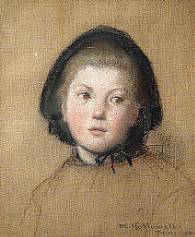
Portrait of a Girl (1890)--representative work

Woman Seated in a Pink Dress--
representative work.
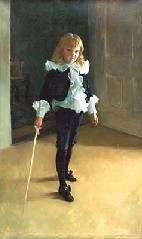
Portrait of a Boy with his
Toy Sword (1894)--
representative work.
Two Portraits (images unavailable)--
exhibited in Fine Arts Palace, 1893 Exposition
Born in Massachusetts, Maria ("May") Hallowell trained at the School of the Museum of Fine Arts and at Cowles Art School in Boston and at the Académie Julian in Paris under Tony Robert-Fleury and others. She was an active exhibitor in the late 1880s through 1910 in Paris, Philadelphia, and Boston. Evidently her main work was in portraits, but she was also known as an art educator. She married Joseph Prince Loud, an architect.
![]()

Clearing in the Woods (1890)--representative work

Haystacks (1890)--representative work
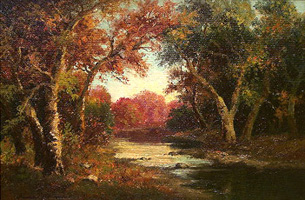
Autumn Landscape--representative work
Study in Green and Scene (images unavailable)
--exhibited in the Women's Department of the
California State Building at the 1893 Exposition.
Annie Lyle Harmon was born in San Francisco into the family of a prosperous lumber merchant. She studied art under California landscape artists Raymond Yelland and then William Keith. She is known to have often exhibited beginning in the 1880s, and she traveled and painted also in Mexico and Australia. Some of her small paintings were signed only with her initials. In the San Francisco earthquake and fire of 1906, 480 of her paintings were destroyed.
Images--click on "Examples of Work"
![]()

Flowers for the Dance--
representative work

The Keepsake--
representative work.
A New Book (image unavailable)
--exhibited in the Rotundra, Women's
Building, 1893 Exposition.
Letitia B. Hart was born in New York into an family of artists. Her father, James M. Hart, and his brother William Hart were both painters, as was her mother, Marie Therese Gorsuch, and Letitia's sister Mary with whom Letitia shared a studio in New York until 1914 and collaborated with on some portraits and genre scenes. She studied art with her father and with Edgar M. Ward and participated in 28 annual exhibitions as well as other exhibitions. She and her sister spent their last years living together in Connecticut.
![]()
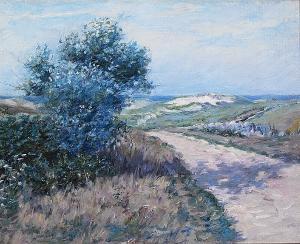
Dunes (1890)--representative work
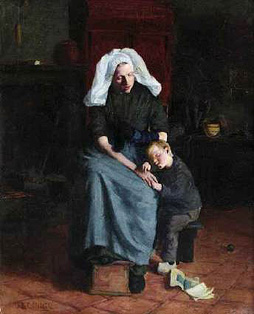
Mother Love (1890) [alternate title:
Where Trouble
Ends]--exhibited
in Fine Arts Palace, 1893 Exposition
Born in California, Ida Haskell received art training in Chicago, Philadelphia, New York, and Paris at the Académie Julian. Evidently her subsequent career alternated between New Orleans and California, but finally she settled in New York where she was a teacher at the Pratt Institute in Brooklyn. Evidently her lifelong companion was photographer Alice Boughton.
![]()
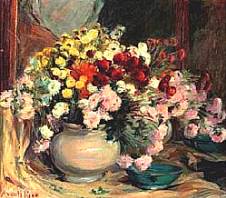
Floral Still Life--representative work
Marigolds (image unavailable)--exhibited
in the Fine Arts Palace, 1893 Exposition.
A Philadelphia painter, Adele von Helmold studied art under William Merritt Chase and Thomas Anshutz at the Pennsylvania Academy of Fine Art. Her married name was Read. No more information is available online.
![]()
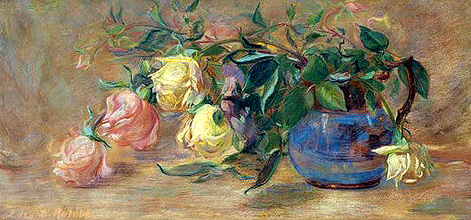
Roses in a Vase--representative work

Portrait of a Seated Lady
--representative work.

Field Laborer
--representative work.

Peasant Woman
with Pitcher, Rome--
representative work.
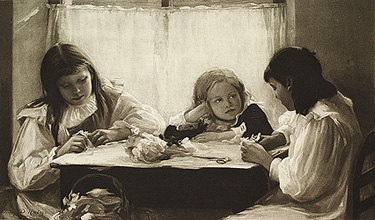
A Holiday Occupation--exhibited in the
Fine Arts Palace, 1893 Exposition
Lucy D. Holme was a Quaker who was born in Elsinboro, NJ and studied art with William Sartain and Thomas Eakin at the Pennsylvania Academy of Art in Philadelphia and with Gustave Courtois and Jean Andre Rixens in Paris. After traveling for several years around Europe, she taught art for many years in Philadelphia. No more information is available online.
![]()
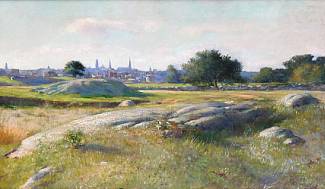
Distant View of Boston--representative work
In the Orchard (image unavailable)--exhibited
in the Fine Arts Palace, 1893 Exposition.
Edith M. Howes studied art in Boston, where she also exhibited and took an active role in local art associations. No more information is available online.
![]()
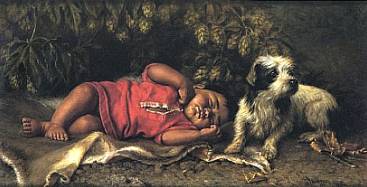
Title unknown [Sleeping Baby and Guard Dog]--representative work
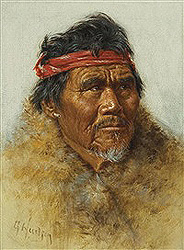
Chief Lau-hau 1899--
--representative work

Sish-ma 1925
--representative work

The Boss (Kay Kah-wy) 1896
--representative work
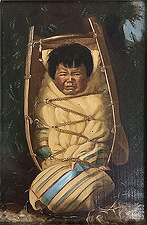
Little Mendocino--
exhibited in the Art
Gallery, California
State Building,
1893 Exposition

The Interrupted Bath
(aka Quail Baby)
--exhibited in the Art
Gallery, California
State
Building,
1893 Exposition.
Grace Carpenter Hudson was raised primarily in Potter Valley, California (north of San Francisco) where her father, Aurelius Ormando Carpenter, was a newspaperman/photographer/rancher (he had earlier served in Kansas with the fiery abolitionist leader John Brown)and her mother, Helen McCowen Carpenter, was one of the first school teachers for the Pomo Indians. The family moved to Ukiah when Grace was four, but by the time she was fourteen, the talented girl was studying art at Hopkins Art Institute in San Francisco with Virgil Williams and Oscar Kunath. At the 1893 Chicago World Fair, her painting of the crying Indian baby called "Little Mendocino" received so much attention that she decided to specialize in Indian themes, and she spent most of the rest of her life actively participating in Indian cultures. The Grace Carpenter Hudson Museum houses the 30,000 Indian objects which she and her second husband, Dr. John Hudson, an ethnologist of Indian cultures, had collected. In 1901 she also spent a year painting natives in the Hawaiian Islands.
![]()
![]()
Go to U.S. Women Painters, p. 7
Return to Women Painters Index
Return to Site Index
![]()
![]()
Text written by K. L. Nichols
Painting, top of page: Marie Konstantinovna
Bashkirtseff,
In the Studio (1881).
Return to Nichols Home Page
Suggestions/Comments: knichols11@cox.net
Posted: 6-25-02; Updated: 5-6-20